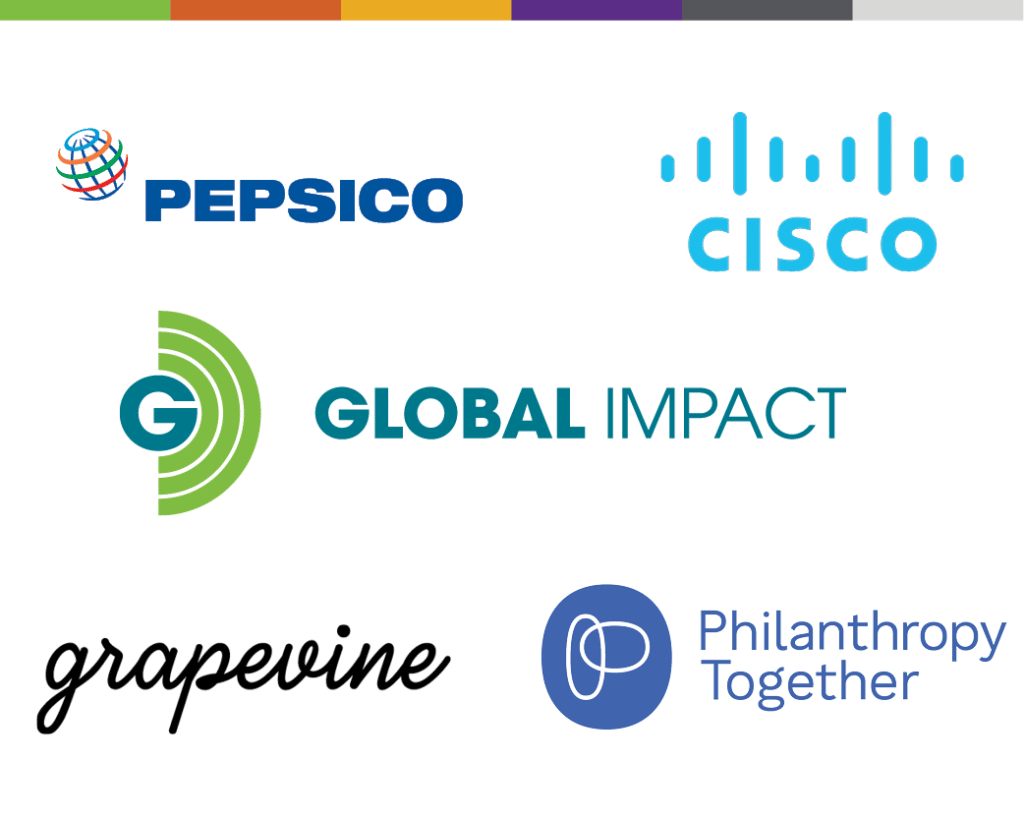Keeping employees happy in “normal” times isn’t always easy – then throw in a global pandemic, generational shifts in the workforce and overall changes in work environments. Needless to say, employers are looking for creative ways to engage their teams and build community within the workplace, especially in the face of the Great Resignation.
With more than 60 years of experience, Global Impact has honed and implemented employee engagement strategies across the private and public sector. To discuss this pressing issue, we brought together four of our partners – PepsiCo, Cisco, Philanthropy Together and Grapevine – for a webinar about modern giving tools and unique approaches for increasing engagement.
After an introduction by Global Impact’s President and CEO Scott Jackson, the speakers jumped right in to share their experiences.
- Sara Lomelin, CEO of Philanthropy Together
- Dennis Jaramillo, Leader with Cisco Conexion Latinx ERG and Giving Circle
- Brittany Craig, Managing Director at Global Impact
- Marcie Passarella, Director of Global Citizenship for PepsiCo
- Emily Rasmussen, Founder CEO of Grapevine
CORPORATE GIVING CIRCLES
What is a giving circle and how can they be used for corporate social impact?
A giving circle is a philanthropic tool that makes giving a collaborative, social experience, bringing together a group of people to make change. For companies, giving circles can provide value at the intersection of the employee experience, business objectives and community impact. They tie employees into the larger grantmaking strategy and build a grassroots level approach to philanthropy. Giving circles look different depending on your approach, but at the core is community. They can connect to different themes, celebrations throughout the year, corporate grantmaking priorities and more.
How does a giving circle work in a corporate setting?
One giving circle at Cisco started with the spark of an idea and a connection to the Latino Employee Resource Group. Some interested folks gathered executive sponsors and started planning events around social causes they cared about. The group identified the key challenges facing their community and began leveraging the entire employee resource group – from the C-suite to junior employees – and made a plan to rally behind their cause: education. From there they connected with local organizations and got to work.
What are the benefits of using a giving circle in the workplace?
Using a giving circle can be very rewarding – and it’s another way of engaging employees. Companies are always looking to strengthen their organization by breaking down silos. Informal groupings like giving circles help connect people across the organization to create new relationships that will benefit the employees and overall business. In addition to connecting about their personal values, this community also talks about work, which can strengthen the opportunity to engage cross-collaboratively. Giving circles also create opportunities for mentorship and the chance to learn from leadership and people who know the organization well.
EMPLOYEE ASSISTANCE PROGRAMS (EAPs)
What is an EAP?
Employee assistance programs are a broader way to increase employee engagement and reinforce company culture. They have taken off over the last few years and can look different depending on how a company chooses to structure them. A typical EAP is offered by a company to provide financial support to employees affected by natural disasters or personal hardship. The company’s foundation provides financial support, but employees are invited to help each other out too.
How does an EAP start?
PepsiCo’s EAP PepHealth originated because of Hurricane Sandy. A significant number of employees were affected by that disaster, and there was an outpouring of interest from employees looking to help their colleagues. Since then, the program has been implemented in the U.S. in response to natural disasters across the country, like the 2021 ice storms in Texas. PepHealth also responds to smaller or individual level disasters like flooding and fires.
What are key factors of a successful EAP?
While organizations can house an EAP in different ways, PepsiCo’s EAP is led by the same team that manages the corporate foundation. They work closely with the human resources team who connects directly with the employee needing financial support. So a collaborative effort across all players is necessary.
Planning an EAP before a disaster hits is critical to long-term success. When the pandemic first hit, there was an urgency among companies to support their employees and identify the kind of assistance needed, but programs had to be established. Those that had preexisting EAPs were set up to activate immediately.
When setting up an EAP, it’s important to consider the potential for future needs as well. The PepHealth EAP originated to support a local disaster, but the program now has reason to address international needs, especially given the situation in Ukraine and surrounding areas.
WHAT’S NEXT?
Whether your company has strategies already in place or you are just getting started, these tools and resources can make your employees feel like they are part of something bigger – ultimately improving morale and commitment to their roles and the company’s mission.
For more information or assistance, reach out to the teams at Global Impact, Philanthropy Together or Grapevine today.
Bonus: Watch the complete webinar to listen to an excellent discussion in the Q&A about the meaning of the word philanthropy!



